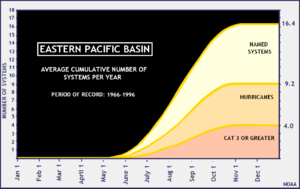Pacific hurricane facts for kids

A Pacific hurricane is a powerful swirling storm that forms over the warm waters of the northeastern and central Pacific Ocean. These storms develop north of the equator and east of the International Date Line. If a similar storm forms in the western North Pacific, it's called a typhoon.
The Pacific Ocean is huge, so for tracking storms, it's split into different areas. The eastern part is from North America to 140°W longitude, and the central part is from 140°W to 180° longitude. Storms rarely form in the central Pacific because of strong winds high up in the atmosphere, which can break them apart.
Contents
When do Pacific Hurricanes Happen?
The official Pacific hurricane season runs from May 15 to November 30 each year. This is when most of these big storms form. However, sometimes a storm can pop up outside these dates.
How Many Storms Form?
The eastern Pacific is one of the busiest places in the world for tropical storms. On average, about 16 tropical storms form each year. Out of these, about 9 become full-blown hurricanes, and 4 grow into very strong "major hurricanes."
|
25
50
75
100
125
150
Jan
Feb
Mar
Apr
May
Jun
Jul
Aug
Sep
Oct
Nov
Dec
|
How Pacific Hurricanes Form
Most Pacific hurricanes start as a "tropical wave." This is a low-pressure area that moves westward across the ocean. As it moves, it picks up warmth and moisture from the ocean. This helps thunderstorms develop. If the conditions are right, with low wind shear (meaning winds don't change much with height), the storm can grow stronger very quickly.
These storms usually form south of Mexico's coast. They get their energy from warm ocean temperatures. Once they move into areas with cooler water or stronger winds, they start to weaken. Sometimes, the leftover clouds and rain from these storms can even reach Hawaii.
Where do Pacific Hurricanes Go?
Most Pacific hurricanes travel west, out into the open ocean, without hitting land. However, some can turn north or northeast. If they do, they might hit Mexico or Central America. It's very rare for a Pacific hurricane to reach the United States as a hurricane. Only one has ever been recorded hitting California as a hurricane, back in 1858.
Sometimes, a storm might even cross over Central America and enter the Caribbean Sea. If it does, it could become an Atlantic hurricane.
A Look Back at Pacific Hurricanes
People have been writing about Pacific storms for a very long time, even since the Spanish first explored Mexico. In the mid-1800s, scientists started studying these storms more closely. They realized that many storms formed off the coast of Mexico.
For a while, the United States Weather Bureau didn't officially recognize these storms. They thought tropical storms only happened in other parts of the world. But as more ships sailed in the Pacific, especially after the Panama Canal opened in 1914, more observations were made. By the 1920s, Pacific hurricanes were finally officially recognized.
Today, we know that the eastern Pacific is the second most active ocean area in the world for tropical storms.
Keeping Track of Storms
Scientists and weather experts keep detailed records of all tropical storms and hurricanes. This information is stored in a special database. This helps them understand how storms form, where they go, and how strong they get. These records are used to create computer models that help predict future storms.
The National Hurricane Center in the United States is the main group that watches over storms in the eastern Pacific. They issue reports and warnings to help people stay safe.
What Affects Storms?
A big area of high pressure called the North Pacific High usually sits in the eastern Pacific. In winter, this high-pressure area creates winds that stop hurricanes from forming. It also helps steer storms away from Hawaii.
Another factor is the El Niño–Southern Oscillation, or ENSO.
- During an El Niño event, the ocean water in the Northeast Pacific gets warmer. This helps more tropical cyclones form and become stronger.
- During a La Niña event, the ocean water is cooler, and winds are stronger. This makes it harder for storms to form in the eastern Pacific.
Central Pacific Storms
The hurricane season for the central Pacific also runs from June 1 to November 30. The busiest time is usually August and September. The Central Pacific Hurricane Center is responsible for watching storms in this area.
It's quite rare for tropical cyclones to actually form in the central Pacific. Most of the storms seen here move in from the eastern Pacific. These storms often weaken as they enter the central Pacific. The only land areas that might be affected by storms in this region are Hawaii and Johnston Atoll. Because these islands are so small compared to the vast ocean, direct hits are not common.
Amazing Pacific Hurricane Records
- Strongest Storm: The most powerful Pacific hurricane ever recorded was Hurricane Patricia in 2015. Its winds reached 215 mph (345 km/h)! This makes Patricia one of the strongest tropical cyclones in the world.
- Longest Journey: Hurricane John (1994) traveled the farthest distance of any tropical cyclone. It journeyed over 7,165 mi (13,280 km) and lasted for more than 30 days!
- Deadliest Storm: The 1959 Mexico hurricane was the deadliest Pacific hurricane. It caused over 1,800 deaths, mostly in Mexico.
See also
 In Spanish: Temporada de huracanes en el Pacífico para niños
In Spanish: Temporada de huracanes en el Pacífico para niños
- Atlantic hurricane
- Tropical cyclone
- Typhoon
- List of tropical cyclone records


